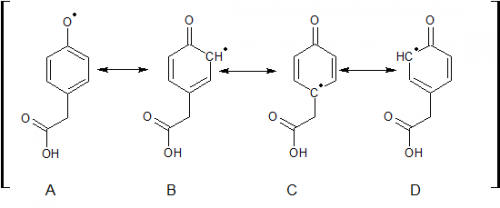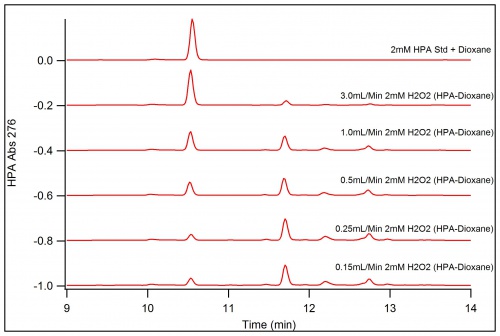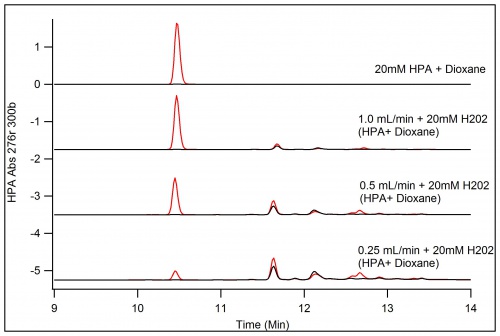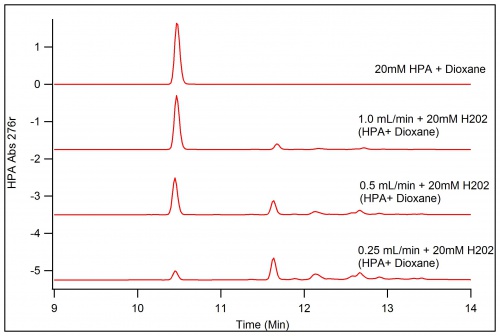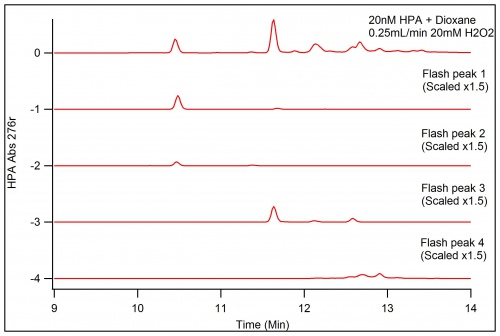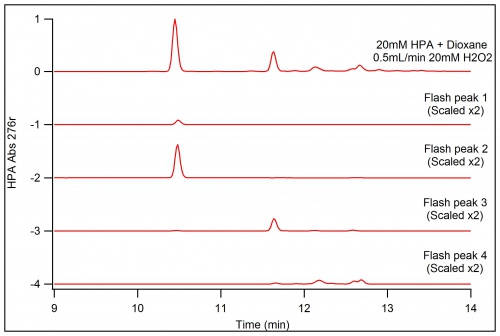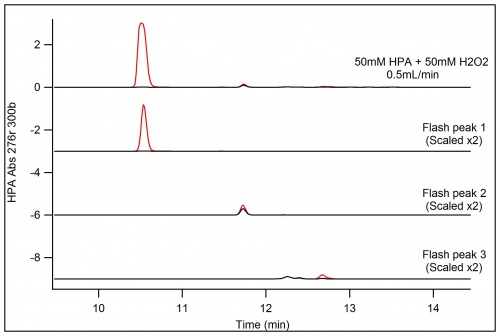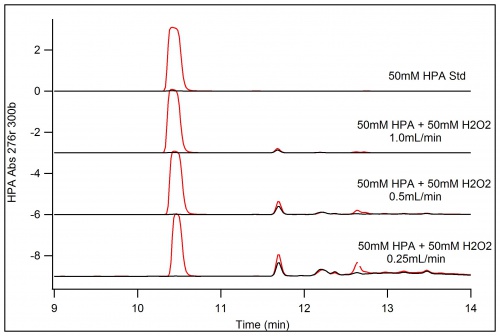HPA Reactions
4-Hydroxyphenylacetic acid (HPA)
Enzyme Oxidation of HPA
The oxidation of HPA forms radicals which form resonance structures and can be combined with each other to form dimers, trimes, and other polymers as a result of oxidation and reduction through an enzyme mechanism.
Radical-Radical Recombinations
The combination of these radicals are the expected products of the reaction and can begin as a combination of the following dimers. An A-A Dimer would create an Organic Peroxide, in which the oxygen radicals create a bond.
A B-B Dimer creates a Carbon-Carbon bond between the 3rd carbon of each HPA monomers. This is also commonly refereed to as a 3-3' bond and is the same as a D-D dimer in that the D radical is on the mirror opposite of the the C radical.
A C-C Dimer would form a bond between the carbon which is attached to the acetic acid group on the HPA phenol. The position of this R group would cause there to be steric hindrance on the bond thus is less likely to form. This is also applicable to other C combination between the radicals.
An A-B Dimer forms an ether bond between the HPA monomers.
Product Identification
Reaction of 50/50 HPA-Dioxane Solution in Buffer with various H2O2 concentrations and Horse Radish Peroxidase (HRP)
Using the Immobilized Enzyme technique, a reaction of HPA-Dioxane and H202 with Immobilized HRP
Trying out different flow speeds with IE to try and see different products. With the greater absorption of HPA There is only a slight change in the products of the reactions'.
To see if there is a change in the product formed at different times within a flow run of HPA + Dioxane through an IE HRP Bioreactor, samples where collected at 2 minutes from the run start, 10 min, 20 min, and 30 min. The rest of the product that was not collected at these specific time intervals was collected together and used as the base comparison, represented by the result labeled 0.25mL/min 20mM H2O2 (HPA + Dioxane)
Immediately after the IE HRP HPA/H2O2 (6/27/16) was run, the bioreactor was cleaned with MOPS buffer in preparation for a second run. At a flow rate of 0.25mL/min and 20mM HPA + Dioxide and 20mM H2O2 conditions, the products of the run where expected to behave in the same way as the trial run previously. However it was seen that the products of the second trial have a lower concentration than that of the previous run.
This change bring into question the change in the conditions within the bioreactor when used continually.
Concentration Test
To increase the amount of product extractable, the concentration of HPA was increased to 50mM as well as the H2O2 concentration, however the same amount of products does not appear as well as the formation of polymers that block products at the 0.25mL/Min run of the immobilized enzyme.
Decreasing the concentration to just 20mM brought the resurgence of the peaks of products. These peaks will be separated in flash chromatography given that they are high enough in yield to be detected by the instrument.
Flash Chromatography Separation
To try to collect a cleaner sample of the products created in the HPA + H2O2 + HRP reaction, Flash chromatography was preformed to separate the peaks.
This is an HPLC of the separation preformed by the Flash Chromatography instrument on the 0.25mL/min 20mM HPA run from 6/23/16. However, the separation of the assumed three product peaks is not clear as can be seen on result labeled Flash Peak 3.
This separation was preformed on a 0.5mL/min 20mM HPA from 6/23/16.
This separation was performed on a 0.25mL/min 20mM HPA from 6/27/16.
This seperation was preformed on a 0.25mL/min 50mM HPA + Dioxane + 50mM H2O2 from 6/30/2016.
This separation was preformed on a 0.5mL/min 50mM HPA from 7/6/16.
IE Without Dioxane Tests
Without adding dioxane to the original solution that is to be flown through the IR, Different flow times and concentration of HPA will be tested.
To see the efficiency of the bioreactor, an test of 20mM HPA with 20mM H2O2 was preformed ad various flow speeds.
With the deduction of Dioxane from the reaction, a 50mM concentration was tested using the Immobilized Enzyme technique and the results are shown below. Because the concentration of the HPA is higher than previous, there seems to be too much for the HPLC to detect fully thus the first standard peak is shown with a rounded tip.
These results suggest that degradation of the HRP on the beads did not occur as it had with the reaction that included dioxane. this is shown by the continual reaction of the beads with the HPA and H2O2 evn after the 0.24mL/min run was completed, and the speed reduced to 0.5 and 1.0mL/min.
NMR Results
After collecting samples through Flash Chromatography, we are able to identify the proton structure of a product using NMR.

